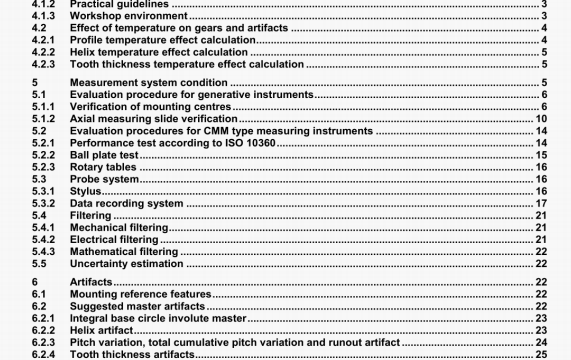ISO TR 10064-5 pdf download – Cylindrical gears一Code of inspection practice一 Part 5: Recommendations relative to evaluation of gear measuring instruments.
6.4.2 Non4nvolute artifact function
Direct calibration of involute profile testing instruments may be accomplished by use of a certified involute artifact Instrument calibration can be further enhanced by the use of a non-involute (planelpinlball) artifact. Non-involute artifact test results provide a collective observation of instrument conformance induding all the instrument’s individual sources of variation, However, unlike the involute artifact, the non-involute artifact combi’ies the individual sources of variation fri a proportion wt’iich does not directly relate to the instrument’s ability to generate a specified reference form. Certain sources of variation, in particular measurement probe position variation, have an exaggerated effect. It is this ctiaractenstlc which permits further refinement of involute profile test instrument calration through observation of non-involute artifact tests.
Non-involute artifact testing is directly affected by slope or ratio type variations of the instrument in the same manner as involute artifact testing This category of error is recognized by a progressive trend of the test trace away from the nominal reference as the test proceeds However, the involute artifact is a preferable reference for this observation since it is simpler and more direct to reference the basically straight involute trace than the highly curved non-Involute artifact trace.
The non-involute artifact can also serve as a reference for observation of form or localized variations, However, owing to the highly curved form of the non-involute artifact trace, involute artifacts manufactured with minimum deviation from specified nominal are preferred.
The characteristic trace of a pin or ball artifact is a smooth curve which mdudes two trend reversals of significant amplitude. This form is recommended as an excellent reference for observation of instrument variations of hysteresis or gain. The plane artifact trace which provides only a single trend reversal before the maximum diameter is encountered is not an appropriate reference for instrument gain.
The non-involute artifact is far more sensitive to variations of instrument probe-tip location than an involute artifact, it is particularly sensitive to positioning variation of the probe tip from the correct location within the plane of action tangent to the base cylinder of the specified involute. The non-involute artifact is the recommended reference for observation of this category of instrument variation,
7 Uncertainty estimation guidelines
The estimation of L uncertainty is to determine how vanous sources of error combine to affect measurement processes When a calibration document or inspection report states a U measurement uncertemty. it certifies that the measured values will be valid, within the stated limits, at a 95 % confidence level.
The determination of measurement uncertainty Is closely tied to instrument calibration: II could be said that an instrument has been calibrated once its measurement uncertainty has been determined. However, it is important to understand that many factors beyond performance of the given instrument can infkience the uncertainty of a measurement process. Often, the contribution of the instrument is small compared to other sources. Therefore, it is better referring to the uncertainty of a measurement process rather than to the uncertainty of an instrument.
Application of any measurement uncertainty calculation will always be limited, These limitations vary considerably dependin9 on the method used, My document stating the results of an instrument calibration or measurement process uncertainty estimation shall provide the associated limitations of applicability, including the measurement parameters, size of the measuring envelope, conftgurations of instrument hardware and software, and environmental conditions.
The uncertainty estimation methods described in this clause comply with GUM.
7.1 Uncertainty estimation methods
Methods for estriatmg measurement uncertainty vary greatly as to complexity, validity, and scope of applicability. Typically, increased validity is achieved only with increased complexity or decreased scope of applicability Selection of an uncertainty estimation method involves striking a balance between these factors,
This document provides a range of example measurement uncertainty estimation methods, Some methods are suitable for use in product gear measurement operations. Others require complex analysis of measurement processes and are only appropriate for high-level measurement operations such as those involved In calibration of reference gear artifacts.
ISO TR 10064-5 pdf download – Cylindrical gears一Code of inspection practice一 Part 5: Recommendations relative to evaluation of gear measuring instruments
